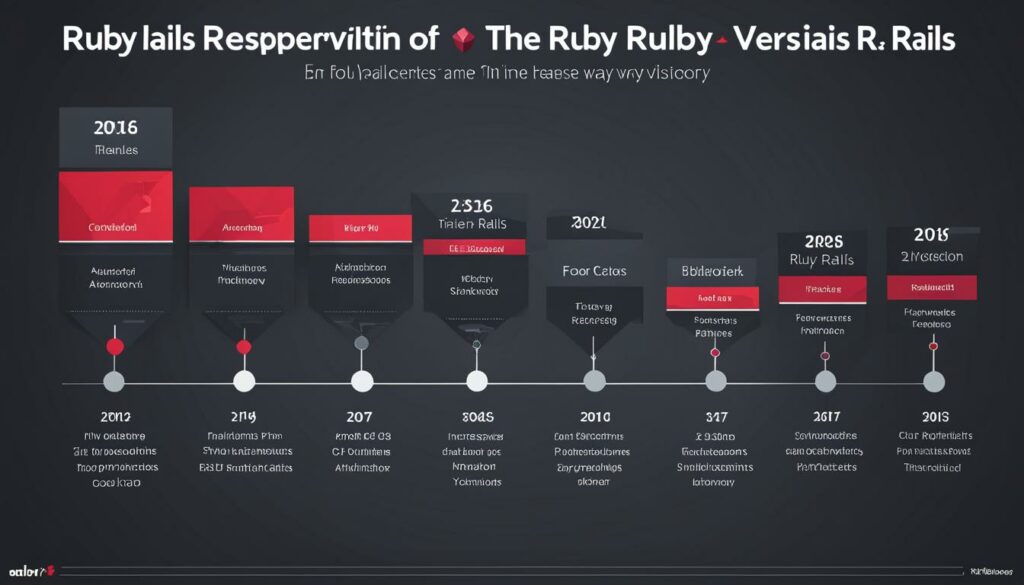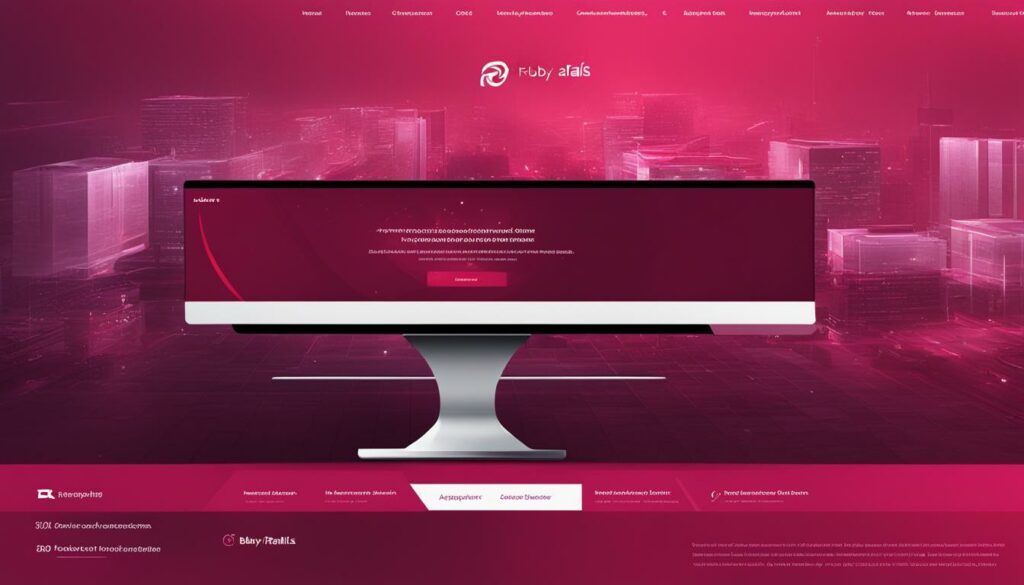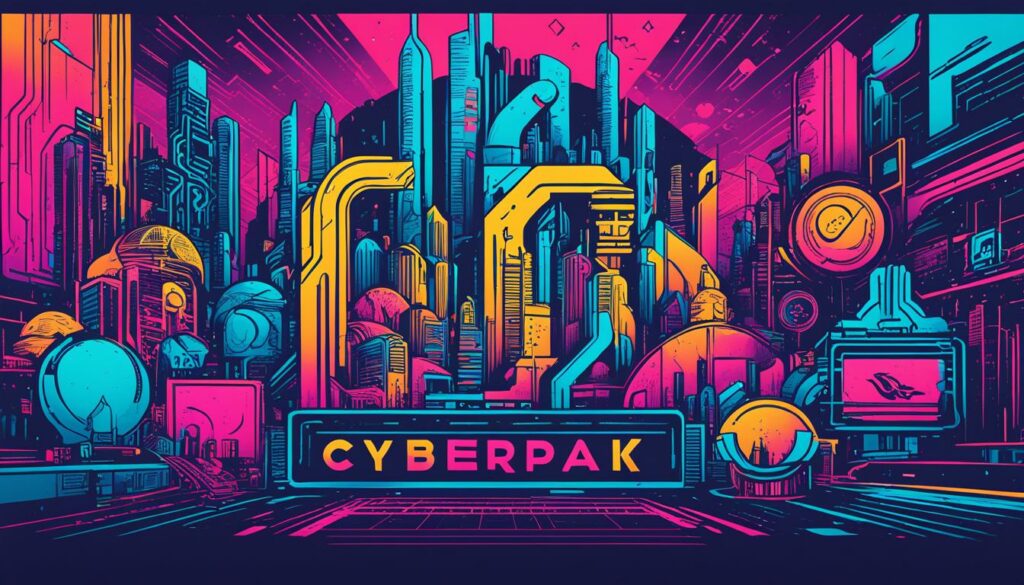Welcome to the world of Ruby on Rails! If you’re exploring web development, you’ve come to the right place. Ruby on Rails is a powerful framework that simplifies web development, making it efficient and enjoyable. Whether you’re a beginner or an experienced developer, learning Ruby on Rails can elevate your skills and help you build impressive web applications.
In this article, we’ll delve into the basics of Ruby on Rails, its framework, and its philosophy. We’ll also discuss its history, the future of the framework, and why it’s worth learning. So, let’s get started on this exciting journey of discovering Ruby on Rails!
Key Takeaways:
- Ruby on Rails simplifies web development, prioritizing efficiency and simplicity.
- The framework follows the Model-View-Controller (MVC) architecture and encourages the “Don’t Repeat Yourself” (DRY) principle.
- Learning Ruby on Rails opens up opportunities for building efficient web applications.
- Ruby on Rails has a strong community and offers a wealth of resources for learning and development.
- BoostedHost provides WordPress Hosting for optimal performance in Ruby on Rails projects.
Now that we’ve laid the groundwork, let’s dive deeper into the world of Ruby on Rails. Continue reading to explore the framework, its design philosophy, and its practical applications in web development.
What is Ruby on Rails?
Ruby on Rails, often referred to as Rails, is a framework built on the Ruby programming language. It aims to simplify web application development by providing default structures for code, application databases, and web pages.
Ruby on Rails follows the Model-View-Controller (MVC) architecture pattern, where the model represents the logic of the application, the view represents the visual representation, and the controller connects the two. This separation of concerns allows for cleaner, more maintainable code.
The framework adheres to the principles of the Rails Doctrine, including the “Don’t Repeat Yourself” (DRY) principle and convention over configuration. The DRY principle emphasizes code reuse and reducing redundancy, while convention over configuration means that Rails makes certain assumptions about the application’s structure, reducing the need for explicit configuration.
Ruby on Rails provides a range of features and tools to streamline the development process. These include ActiveRecord, an object-relational mapping (ORM) layer that simplifies database integration, and Action Pack, which handles request and response cycles. Rails also offers the Asset Pipeline, which helps manage static assets like JavaScript and CSS files, and prioritizes security practices to protect against common vulnerabilities.
Overall, Ruby on Rails is a powerful framework that combines the flexibility of Ruby with the efficiency of predefined structures, making it an excellent choice for web developers looking to build robust and scalable applications.
The Ruby on Rails Design Philosophy
The design philosophy of Ruby on Rails is centered around key principles that guide its development and usage. These principles, such as the “Don’t Repeat Yourself” (DRY) philosophy and convention over configuration, make Ruby on Rails a powerful and efficient framework for web development.
The DRY principle encourages developers to reduce repetition in their codebase by creating modular and reusable functions or files. By avoiding duplication, developers can maintain a codebase that is easier to manage, update, and debug. Ruby on Rails simplifies this process by leveraging metaprogramming, a feature of the Ruby programming language, to generate code dynamically. This allows developers to keep their code DRY without sacrificing flexibility.
Convention over configuration is another key principle of Ruby on Rails. Instead of requiring developers to make explicit configuration decisions for every aspect of their application, Ruby on Rails sets sensible defaults based on commonly accepted best practices. This reduces the amount of time and effort spent on configuration, allowing developers to focus on building the core functionality of their application. Of course, Ruby on Rails also provides the flexibility to override these conventions when necessary, giving developers full control over their project.
“Convention over configuration is a big deal. Having sensible defaults and avoiding decisions when unnecessary frees you up to focus on the domain problems.” – David Heinemeier Hansson
The Rails Doctrine, which encapsulates the philosophy of Ruby on Rails, emphasizes the importance of these principles in creating an efficient and productive development experience. By following these design principles, Ruby on Rails enables developers to build robust and scalable web applications with less code and greater ease.

Ruby on Rails Design Philosophy: Key Points
- The “Don’t Repeat Yourself” (DRY) principle encourages developers to reduce repetition and create modular code.
- Convention over configuration sets sensible defaults, reducing the need for explicit configuration decisions.
- Metaprogramming in Ruby allows for dynamic code generation and keeps code DRY.
History of Ruby on Rails
Ruby on Rails, often referred to as Rails, has an intriguing origin story. It was created by David Heinemeier Hanson, while he was working at Basecamp, a project management tool. David wanted to find a more efficient and enjoyable way to develop web applications, considering the repetitive nature of certain tasks.
In 2004, David open-sourced Ruby on Rails, making it accessible to developers worldwide. This decision marked a significant turning point in the framework’s evolution, as it allowed a dedicated core developer team and a large community of open-source contributors to emerge.
Since its open-source release, Ruby on Rails has undergone multiple updates and version releases to enhance its functionality, security, and performance. The latest stable release is 6.1.3.2. Despite being over a decade old, Ruby on Rails remains a widely used web framework with a strong reputation in the developer community.
“Open-sourcing Ruby on Rails was a game-changer for the framework. It transformed Ruby on Rails from a proprietary tool into a collaborative community environment, allowing developers everywhere to contribute to its development and growth.”
The Evolution of Ruby on Rails
Ruby on Rails has come a long way since its inception. It has evolved to meet the changing needs of web development and adapt to new technologies and trends. The framework has continually improved its performance and security features, allowing developers to build robust and scalable web applications more efficiently.
The following table highlights the significant updates and releases in the evolution of Ruby on Rails:
| Version | Release Date | Notable Features |
|---|---|---|
| 1.0 | December 13, 2005 | Initial stable release |
| 2.0 | December 7, 2007 | Introduction of RESTful architecture and Active Record associations |
| 3.0 | August 29, 2010 | Integration of the asset pipeline and the introduction of a new router |
| 4.0 | June 25, 2013 | Introduction of Russian Doll caching and Turbolinks |
| 5.0 | June 30, 2016 | Introduction of Action Cable for real-time web applications |
| 6.0 | August 15, 2019 | Enhancements in performance, multi-database support, and Action Mailbox |
Ruby on Rails continues to evolve with each new release, keeping up with the latest trends and addressing the needs of modern web development. The framework’s ability to adapt to change has been crucial in maintaining its relevance and popularity.

As the image illustrates, Ruby on Rails has grown from its humble beginnings to become a mature and versatile framework that powers numerous web applications.
The Future of Ruby on Rails
While there have been discussions about the popularity and relevance of Ruby on Rails, the framework continues to evolve and adapt. It’s true that it may have slipped in popularity rankings, but that doesn’t negate its potential and significance in the web development landscape. And here’s why.
The active involvement of the Ruby on Rails community and its open-source nature ensure that developers who choose to use the framework will have access to consistent updates, improvements, and a network of support. This means that regardless of any dip in popularity, the future of Ruby on Rails is secure and promising.
Ruby on Rails has proven its resilience by integrating with emerging technologies such as AI and machine learning. This adaptability attracts developers and businesses seeking to build innovative applications that leverage these cutting-edge advancements. The versatility of Ruby on Rails makes it an agile and future-proof choice for web development projects.
One of the key reasons behind Ruby on Rails’ continued relevance is its robust community. The developers using the framework contribute to its growth and evolution. They collaborate, share knowledge, and build upon each other’s work, creating a thriving ecosystem. This strong community support ensures that Ruby on Rails remains a viable option for years to come.
Ruby on Rails Popularity Trends
While the popularity of Ruby on Rails may have fluctuated over time, it remains a widely recognized and respected framework in the industry. The framework has been instrumental in building successful and high-profile projects such as Airbnb, Shopify, and GitHub.
Although other frameworks have gained attention, Ruby on Rails continues to have a loyal following among developers who appreciate its elegant syntax, conventions, and ability to boost productivity. It’s worth noting that legacy projects built with Ruby on Rails also contribute to its ongoing relevance and maintenance.
The future of Ruby on Rails is bright, with its adaptability and community support paving the way for continuous growth and improvement. The framework remains an excellent choice for developers looking for an efficient and powerful tool to build modern web applications.

Sign up now for BoostedHost’s WordPress Hosting to ensure optimal performance for your Ruby on Rails projects. With BoostedHost, you’ll have access to the latest technologies and excellent support. Sign up here.
Why Learn Ruby on Rails?
If you’re a beginner venturing into the world of web development, Ruby on Rails is an excellent choice. With its thriving online community and accessibility, this language and framework provide a solid foundation for your coding journey. Here are some compelling reasons why you should consider learning Ruby on Rails:
Simplifies Web Application Development
Ruby on Rails simplifies the process of building web applications by providing default structures and reducing the need for extensive theoretical knowledge before you start coding. This means you can dive right into creating functional and interactive websites without getting lost in complex syntax or architecture.
Career Opportunities
Learning Ruby on Rails opens up numerous career opportunities in various types of companies. Many startups and established organizations rely on this framework for their web development needs, so there is a demand for skilled Ruby on Rails developers. By mastering this framework, you can position yourself for a successful career in the ever-growing field of web development.
Efficient and Fast Development
Ruby on Rails offers a more efficient and faster way to build websites compared to other frameworks. Its built-in conventions and streamlined workflows help developers write clean, concise code, resulting in quicker turnaround times for projects. If you want to see tangible results of your work sooner, Ruby on Rails can help you achieve that.
The Success of Companies Using Ruby on Rails
Many successful companies, such as Airbnb, GitHub, and Basecamp, have built their websites or applications using Ruby on Rails. This showcases the effectiveness of the framework in creating engaging and functional websites that can handle high levels of traffic. By learning Ruby on Rails, you gain access to the tools and resources used by these industry-leading companies.
Embrace the advantages of Ruby on Rails for beginners and discover the exciting possibilities that await you in the field of web development.
How to Learn Ruby on Rails
Learning Ruby on Rails can be an exciting journey, and fortunately, there are numerous resources and tutorials available online to help you get started. These valuable learning materials provide step-by-step guidance on various aspects of Ruby on Rails, including installation, project creation, MVC architecture, database integration, and deployment options.
One great way to enhance your learning experience is by engaging with online communities and forums dedicated to Ruby on Rails. The Ruby on Rails community offers support and guidance for learners at all levels. You can ask questions, share ideas, and connect with fellow developers who are passionate about Ruby on Rails.
“Learning Ruby on Rails is like embarking on an adventure with a supportive and collaborative community by your side.”
If you prefer more structured learning, there are books, online courses, and interactive coding platforms available. These resources provide comprehensive lessons and exercises to help you grasp the concepts and techniques of Ruby on Rails effectively. By following structured curricula, you can gain a solid foundation in web development using Ruby on Rails.
While theoretical knowledge is essential, practical experience is equally valuable. As you learn Ruby on Rails, it’s crucial to apply your knowledge by building projects. By working on real-world applications, you can solidify your understanding of the framework and develop the problem-solving skills necessary for successful development.
It’s also essential to stay updated with the latest releases and updates in the Ruby on Rails framework. This ensures that you are aware of any new features, improvements, or security updates. Continuous learning is a key aspect of becoming proficient in Ruby on Rails.
Recommended Resources for Learning Ruby on Rails
Here are some highly recommended resources to kickstart your learning journey in Ruby on Rails:
-
Online Communities: Join the active and vibrant Ruby on Rails community by participating in forums and online discussions. Some popular online communities include:
- Ruby on Rails official forum
- Reddit’s Ruby community
- Stack Overflow’s Ruby on Rails tag
-
Books: Explore renowned books written by experienced developers that cover various aspects of Ruby on Rails. Some recommended titles include:
- “Agile Web Development with Rails” by Sam Ruby, Dave Thomas, and David Heinemeier Hansson
- “The Rails 5 Way” by Obie Fernandez
- “Ruby on Rails Tutorial: Learn Web Development with Rails” by Michael Hartl
-
Online Courses: Enroll in online courses taught by industry professionals to receive structured and guided instruction on Ruby on Rails. Some popular online learning platforms that offer Ruby on Rails courses include:
- Udemy
- Codecademy
- Pluralsight
- Treehouse
-
Interactive Coding Platforms: Practice your Ruby on Rails skills through hands-on coding exercises and projects on interactive platforms such as:
- Codecademy
- Exercism
- Codewars
Learning Ruby on Rails is an exciting and rewarding endeavor. By leveraging the available resources, engaging with the community, and continuously building projects, you can become proficient in this powerful web development framework.

| Resource | Description |
|---|---|
| Online Communities | Engage with the Ruby on Rails community for support and guidance throughout your learning journey. |
| Books | Explore renowned books written by experienced developers to delve deeper into Ruby on Rails. |
| Online Courses | Enroll in online courses taught by industry professionals to receive structured instruction on Ruby on Rails. |
| Interactive Coding Platforms | Practice your Ruby on Rails skills through hands-on coding exercises and projects on interactive platforms. |
A Day in the Life of a Ruby on Rails Developer
A Ruby on Rails developer plays a crucial role in the world of web application development. Every day, you’ll immerse yourself in a range of tasks that involve leveraging the power of the Ruby on Rails framework to create efficient and robust applications. Here’s a glimpse into the daily routine of a Ruby on Rails developer:
Coding and Development
As a Ruby on Rails developer, a significant portion of your time is dedicated to coding. You’ll be writing code in Ruby, implementing application features based on project requirements, and ensuring that the functionality and performance of the application meet the desired standards. Whether it’s building new features or enhancing existing ones, you’ll use your coding skills to bring ideas to life.
Debugging and Testing
Ensuring the reliability and stability of the application is another crucial aspect of your role. You’ll spend time debugging code, identifying and fixing errors or issues, and running rigorous tests to validate the functionality of the application. Thorough testing is essential to ensure that the application works seamlessly and provides an exceptional user experience.
Collaborating with Team Members
Effective collaboration is vital in any development project. As a Ruby on Rails developer, you’ll work closely with designers, frontend developers, and other team members to create cohesive and visually appealing applications. Collaborating with others allows for the creation of a well-rounded product that meets both user requirements and design standards.
Database Integration
Database integration is a fundamental aspect of web application development. In your role, you’ll work with database systems to store and retrieve data efficiently. This involves designing and implementing secure database structures, optimizing database queries, and ensuring data integrity within the application.
Security Implementation
Security is a paramount concern in today’s digital landscape. As a Ruby on Rails developer, you’ll be responsible for implementing industry best practices and security measures to protect user data and safeguard the application from potential vulnerabilities. This includes managing access controls, encrypting sensitive information, and staying updated with the latest security practices.
Performance Optimization
Optimizing the performance of the application is a continuous endeavor. You’ll analyze and identify areas where the application can be optimized, such as reducing page load times, improving query efficiency, and optimizing resource utilization. Implementing performance enhancements ensures that the application can handle increasing user demands and delivers a smooth user experience.
Continuous Learning and Professional Growth
The field of web development is ever-evolving, and as a Ruby on Rails developer, staying updated with the latest industry trends and best practices is crucial. Devoting time to continuous learning, exploring new technologies, and improving your coding skills will contribute to your professional growth and enable you to tackle more complex projects in the future.
Being a Ruby on Rails developer is both challenging and rewarding. By utilizing your coding expertise, collaborating with team members, and applying industry best practices, you’ll contribute to the successful development and deployment of innovative web applications.
Routine Tasks of a Ruby on Rails Developer
As a Ruby on Rails developer, you have several responsibilities and tasks that contribute to the successful development of web applications. Your primary focus is on writing code in the Ruby programming language and implementing features based on project requirements. This involves using Ruby on Rails framework to create efficient and functional applications.
One of your key responsibilities is to ensure the proper functionality and performance of the application. You work with the Model-View-Controller (MVC) architecture to structure the code, separating the business logic (model), the presentation (view), and the user interactions (controller). This architecture allows for code reusability and maintainability, making it easier to handle complex projects.
Collaboration is an integral part of your role as a Ruby on Rails developer. You work closely with designers to implement their designs and ensure a cohesive application. You also collaborate with frontend developers to integrate their work with the backend functionality you provide. Working with other team members and stakeholders is essential to ensure that the application meets the project requirements and objectives.
In addition to coding and collaboration, you may be involved in debugging, testing, and troubleshooting issues that arise during the development process. Identifying and addressing bugs and errors helps maintain the quality and reliability of the application. Keeping up with industry best practices and security measures is also important to protect the application from potential vulnerabilities.
Overall, as a Ruby on Rails developer, your routine tasks revolve around coding, implementing features, ensuring application functionality and performance, collaborating with team members, and maintaining industry best practices. Your work contributes to the successful development of efficient and robust web applications.
Skills and Personality Traits of a Ruby on Rails Developer
To be a successful Ruby on Rails developer, you need a combination of technical skills and desirable personality traits. Let’s explore the key qualities that make a Ruby on Rails developer excel in their field.
Technical Skills:
- Proficiency in Ruby: As the foundation of Ruby on Rails, a deep understanding of the Ruby programming language is essential.
- Understanding of MVC Architecture: The Model-View-Controller architecture is the backbone of Ruby on Rails. Familiarity with this structure allows developers to build scalable and maintainable applications.
- Knowledge of Web Development Fundamentals: Comprehension of HTML, CSS, and JavaScript forms the basis for creating dynamic and interactive web applications.
- Experience with Database Systems: Working with database systems like SQL enables developers to deliver robust and efficient data management solutions.
Personality Traits:
- Problem-Solving Skills: A successful Ruby on Rails developer possesses strong problem-solving abilities to tackle complex coding tasks and debug issues effectively.
- Attention to Detail: Meticulous attention to detail ensures that every line of code is accurate and error-free, resulting in reliable and secure applications.
- Logical Thinking: The ability to think logically allows developers to break down complex problems into manageable components, leading to efficient code development.
- Collaboration and Communication: Working as part of a team is common in Ruby on Rails development. Effective communication and collaborative skills enable seamless cooperation with designers, frontend developers, and other stakeholders.
- Adaptability: The field of web development is constantly evolving. A successful Ruby on Rails developer embraces change, adapts to new technologies and methodologies, and stays up-to-date with industry advancements.
Continuous learning is key to thrive as a Ruby on Rails developer, as it ensures you’re equipped with the latest tools and techniques. By combining technical skills with desirable personality traits, you can become a successful Ruby on Rails developer and contribute to the ever-growing field of web development.
Conclusion
Exploring Ruby on Rails can open up a world of possibilities for efficient web development. This powerful framework is built on the principles of simplicity and efficiency, providing developers with a solid foundation for building dynamic and robust web applications.
One of the key advantages of Ruby on Rails is its vibrant community, which offers a range of resources and support for learning. Whether you’re a beginner or an experienced developer, you’ll find a thriving ecosystem of gems and tools that can enhance your development process.
Ruby on Rails simplifies web application development through convention over configuration and the “Don’t Repeat Yourself” (DRY) principle. By minimizing repetitive tasks and providing sensible defaults, the framework allows developers to focus on writing clean and maintainable code.
Despite discussions about its popularity, Ruby on Rails continues to evolve and remains relevant in the industry. Its adaptability, integration with emerging technologies, and strong community support ensure its continued use and growth.
In summary, learning Ruby on Rails can lead to a successful career in web development. With its emphasis on efficiency, simplicity, and a vibrant developer community, Ruby on Rails provides an excellent foundation for creating impactful and functional web applications.
FAQ
Q: What is Ruby on Rails?
A: Ruby on Rails is a framework built on the Ruby programming language that simplifies web application development. It provides default structures for code, application databases, and web pages, follows the Model-View-Controller (MVC) architecture pattern, and adheres to the principles of convention over configuration and the “Don’t Repeat Yourself” (DRY) principle.
Q: What is the design philosophy of Ruby on Rails?
A: The design philosophy of Ruby on Rails is centered around principles such as the “Don’t Repeat Yourself” (DRY) principle and convention over configuration. It encourages reducing repetition in code, modular and maintainable functions, and sensible defaults to simplify development and allow developers to focus on building the application.
Q: Who created Ruby on Rails and when was it open-sourced?
A: Ruby on Rails was created by David Heinemeier Hanson and extracted from his work at Basecamp. It was open-sourced in 2004 and has since grown and evolved with the involvement of a dedicated core developer team and a large community of open-source contributors.
Q: What is the future of Ruby on Rails?
A: The future of Ruby on Rails remains strong as the framework continues to evolve and adapt. While its popularity rankings may have varied, the active involvement of the community and its open-source nature ensure that developers using Ruby on Rails will have access to updates and support. Ruby on Rails integrates with emerging technologies and adapts to the changing needs of web development.
Q: Why should I learn Ruby on Rails?
A: Learning Ruby on Rails offers advantages such as its vibrant online community, accessibility for beginners, and opportunities for career growth. Ruby on Rails simplifies web application development, allowing developers to see tangible results sooner and providing a stable industry with demand for these skills.
Q: How can I learn Ruby on Rails?
A: You can learn Ruby on Rails through various online resources and tutorials that provide step-by-step guidance on installation, project creation, MVC architecture, database integration, and deployment options. Online communities, forums, books, online courses, and interactive coding platforms offer structured learning experiences. Practical experience and building projects are crucial for gaining proficiency, and staying updated with the latest releases and updates is important.
Q: What are the routine tasks of a Ruby on Rails developer?
A: Routine tasks of a Ruby on Rails developer include coding, debugging, and testing application features, collaborating with team members, ensuring the scalability and reliability of the application, database integration, security implementation, and performance optimization.
Q: What are the skills and personality traits of a successful Ruby on Rails developer?
A: A successful Ruby on Rails developer possesses technical skills such as proficiency in Ruby, understanding of MVC architecture, knowledge of web development fundamentals, and experience with database systems. Problem-solving, attention to detail, logical thinking, collaboration, communication, adaptability, continuous learning, and staying updated with industry advancements are important traits for a Ruby on Rails developer.












